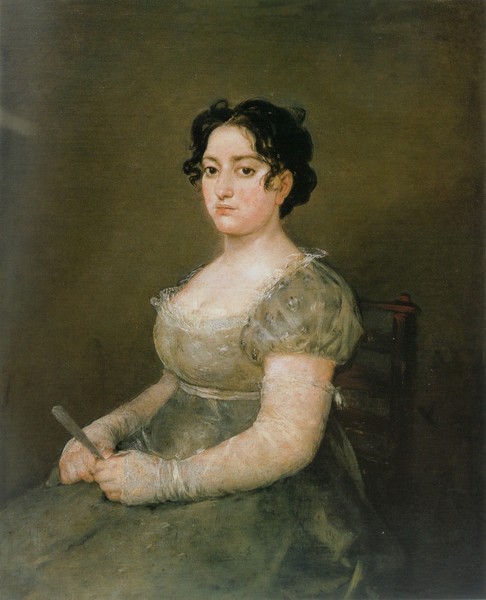- Cronología
- Ca. 1806 - 1807
- Ubicación
- Musée du Louvre, París, France
- Dimensiones
- 103 x 83 cm
- Técnica y soporte
- Oil on canvas
- Reconocimiento de la autoría de Goya
- Documented work
- Titular
- Musée du Louvre
- Ficha: realización/revisión
- 12 Apr 2010 / 16 Jun 2023
- Inventario
- (1132)
This painting was initially in the possession of the Goya family. It later entered the collection of the Marquis of Salamanca, who purchased it from Mariano Goya, the artist's grandson. Subsequently, it belonged to the collection of Alfonso Oudry, who sold it to a Mr Edwards, who in turn sold it to Mr. Kums.
The work was finally acquired by the Louvre in 1898.
Today, the identity of the woman depicted in the portrait is not known for certain. Different scholars of Goya's work have varying opinions on the matter. Gudiol identifies this woman as Doña Catalina Viola, according to the inventory of Goya's belongings made by Brugada. Xavier de Salas and Enriqueta Harris both affirm that this lady could be Gumersinda Goicoechea, whom Goya painted in 1805 on one of the medallions made to commemorate her wedding to Javier Goya, the artist's son. The facial similarities between the two portraits suggest that they could well be of the same person, although in this painting the sitter appears fuller of figure, owing, according to Harris, to the fact that she was pregnant with or had just given birth to Mariano, Goya's only grandchild.
The subject is depicted in front of a neutral background, seated on a simple wooden chair. She wears a lightweight grey dress with a pronounced neckline decorated with sheer lace. Her arms are covered by semi-sheer gloves which are left open at the hand to reveal her fingers, in which the sitter holds a closed fan that she appears to be playing with.
Her rosy face is turned to look out at the viewer, her large, dark and slightly fallen eyes standing out.
The most remarkable thing about this work is perhaps the difference between the finish used on the face and the light brushstrokes used on the dress, which help to give an overall effect reminiscent of those achieved much later by the Impressionists.
-
Peintures de Goya des collections de FranceMusée de l’OrangerieParís1938cat. 13
-
cat. 67
-
Goya and his timesThe Royal Academy of ArtsLondon1963cat. 66cat. 93
-
Trésors de la peinture espagnole, Eglises et Musées de FrancePalais du Louvre and Musée des Arts DécoratifsParís1963from January to April 1963cat. 118
-
GoyaKoninklijk Kabinet van Schilderijen MauritshuisThe Hauge1970organized by Ministerio de Estado y Asuntos Culturales and Réunion des Musées Nationaux, July 4th to September 13th 1970. Exhibited also at the Musée de l’Orangerie des Tuileries, Paris, October 25th to December 7th 1970, consultant editors Jeannine Baticle and A. B. de Vriescat. 37
-
Goya. La imagen de la mujerMuseo Nacional del PradoMadrid2001from October 30th 2001 to February 10th 2002. Exhibitied also at the National Gallery of Art, Washington, March 10th to June 2nd 2002, consultant editor Francisco Calvo Serrallercat. 73
-
Goya: Prophet der ModerneAlte NationalgalerieBerlin2005from July 13th to October 3th 2005. Exhibitied also at the Kunsthistorischemuseum, Vienna, October 18th 2005 to January 8th 2006, consultant editor Manuela B. Mena Marquéscat. 87
-
Agen2019cat. 13
-
L'œuvre peint de Goya. 4 volsParís1928-1950p. 179, cat. 466
-
Vie et ouvre de Francisco de GoyaParísOffice du livre1970p. 262, cat. 890
-
BarcelonaPolígrafa1970vol. I, p. 368, cat. 659
-
Goya, la imagen de la mujerMadridMuseo Nacional del Prado y Fundación Amigos del Museo del Prado2001pp. 268 y 269 (il.), cat. 73
-
AgenSnoeck2019p. 103
-
www.louvre.fr, consultada el 13-04-1013-04-10
